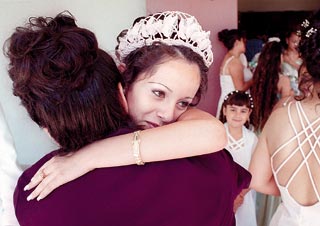 ¡Descubre español!
¡Descubre español!
 ¡Descubre español!
¡Descubre español!

By Kimberly K. Fu
Leticia Saucedo has been up since 6:30 a.m., too nervous about the day's coming events to sleep. She has eaten little.
The petite, slender teenager has already spent two hours lounging in a swivel chairs at G. Norman Hair, having her shoulder-length brunette tresses swept up in an elegant style.
She now returns to her Beard Court home to rest before her sisters swoop in for a makeup session. Then she pulls on her pale pink formal.
It's time for her quinceañera.
"It's like a 'coming out' party," she explains. "A Sweet 16 but at 15."
In Mexican culture, a quinceañera celebrates a girl's transition from child to woman on her 15th birthday. It is intended to reward her purity of mind, body and spirit, renew her bond with God and strengthen her ties to her family and community.
The tradition dates back to ancient Mexico in the time of the Mayas and Aztecs, Quechua and Toltecs, Tainos and Arawaks. Back then, youths were considered adults at age 15. Boys became warriors and girls were honored as future mothers.
Admittedly "far away" from even thinking about motherhood, Leticia says she is looking forward to observing her birthday in a manner befitting her Mexican ancestry.
"I think it's important because it can only happen one time," she says. "You can't go back to 15."
Leticia actually turns 15 on July 9, but the big party comes one day early - the same day as her grandmother's birthday.
Her two older sisters tease her, saying she doesn't have any worries today, because she's like royalty. Her duty: to sit back, relax and be fussed over.
She disagrees.
"I don't feel like a princess," she says. With a toss of her head, a halo of raven curls forms about her face. She grabs a stray curl and twirls it absently.
A reward for goodness
Now, just hours away from her party, Leticia says she never believed the event would really happen.
Quinceañeras are for "good girls," she says, and like all youngsters her age, she has moments when her temper runs hotter than it should.
"You're supposed to get a quinceañera if you deserve it," says Leticia. "They're not going to give you a party if you're rebellious."
Neither her grandmother, mother nor her two older sisters could afford a quinceañera. But Leticia's parents were determined to provide for at least one of their four girls.
Although tradition dictates that friends and relatives aid in providing a quinceañera, the family chose to bear the costs alone. Pride was a major factor in this decision, Leticia says.
"There's a lot of people who ask for help, but my mom didn't like that," she says. "She wasn't going to make them (help out)."
Instead, the family scrimped and saved and scraped together about $8,000 to give Leticia a lavish bash that she would remember forever.
"She's a good girl and I think she deserves it," says Leticia's mother, Graciela.
To ensure the perfect party, the family began planning last September for the July event.
It was a good thing they started early. As extravagant as a wedding, a quinceañera's preparations can be overwhelming. In addition to gowns for the birthday girl and her eight attendants, the family had to secure a church, a mariachi band, stretch limos to transport the quinceañera party and a reception site.
Finding 'the dress'
Graciela recalls the hunt for the dress.
It took months - and several trips around the Bay Area - to find the perfect quinceañera dress.
"I say, 'Do you like this or that?' and she say, 'No,' " Graciela says, shaking her head at the memory. She was thrilled when Leticia finally found the dress of her dreams in Concord and all the necessary accessories in Santa Rosa.
"I always knew the kind of dress I wanted," says Leticia, holding out a fairytale gown in the palest of pinks, "Just fitted and out," she said, her arms stretching wide to demonstrate the pouf of her flouncy skirt ... "and pink."
Graciela then turned her attention to the "small" things.
"I'm running since a month or two ago," she says. "I made all the flowers for the escorts, the centerpieces."
Adds Leticia, "My mom's been the busiest, doing everything."
Surrounded by her sisters, Leticia leaves for the church. As Graciela watches her daughter walk away, she mourns the child she's lost but praises the woman she's become.
"I think I treat her the same," she says. "She still is my baby."
A new commitment
The family secured St. Mary's Catholic Church in Vacaville for the religious part of the quinceañera.
Important in Mexican and Spanish but not Cuban cultures, the religious ceremony formally binds the birthday girl to her community and defines her responsibilities as an adult.
At 2 p.m., Leticia and her party arrive at St. Mary's. They alight from their limousines and form a line, awaiting their turn to enter the church.
Leticia's attendants, dressed in sage-colored gowns, walk in first, followed by two of her nieces. She enters last, accompanied by her parents. They sit in a pew near the front of the church. She mounts the steps, taking her place at a podium facing the priest.
During the two-hour mass, conducted in Spanish, Bible passages are read, hymns are sung and the seven-piece mariachi band plays.
But most importantly, Leticia reiterates her loyalty to her community, family and to God. The priest points out her responsibilities as an adult, and she agrees to accept them.
To help her on her new path, four sacred items are blessed, then given to her: A delicate silver medal, which signifies faith; a simple ring, which symbolizes the tie between the girl, her community and God; a multi-tiered pink crown, a sign of the victory of the wearer's ability to live a Christian life amid the challenges of her environment; and two bouquets of long-stemmed roses, one white and one pink, representing new life.
Near the end of the ceremony, Leticia takes communion. After the last prayer, her parents escort her out of the church.
After a round of picture-taking, the quinceañera party heads into the waiting limousines, eager to get to the less-formal reception at Three Oaks Community Center.
A special dance
More than 150 guests of all ages gather at the community center where the mariachi band continues to play, supplemented by a DJ who plays contemporary Mexican music.
The family serves simple, filling fare, which they prepared: beans and rice, tortillas and a beef dish. For dessert, there is a cake provided by one of Leticia's older sisters.
The highlight of the evening is the night's first dance. Following custom, Leticia dances it with her father, Petronill. Her filmy skirt swirls around them as they twirl, lost in the music.
Looking back, it's the memory Leticia will always treasure, "the dance with my dad."
This information comes from:
http://www.thereporter.com/Specials/LaVida/03/0303.html